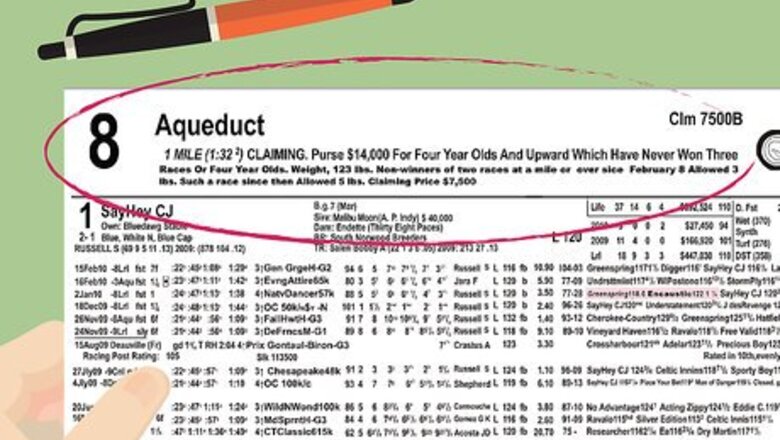
views
Reviewing Race Information
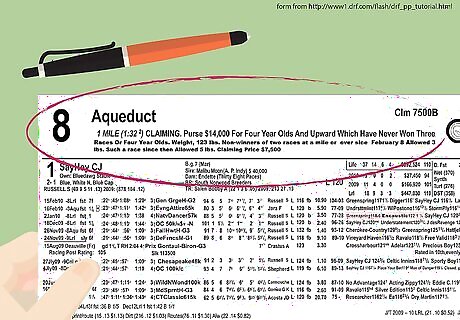
Scan the header. All of the general information about the race will be available at the header of the Racing Form. It will be located above other information, in larger fonts, separated from the body of the text by a line.
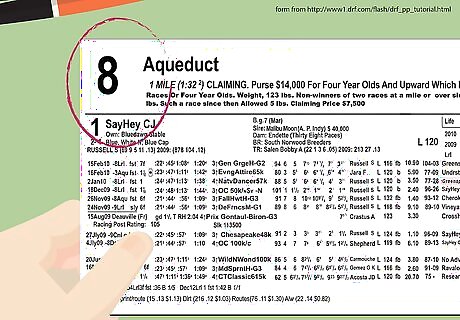
Find the race number. This will be located on the left-hand side of the header, in large font. Because most tracks run several races per day, this is used to distinguish between different races. It will typically be a number from one to ten.
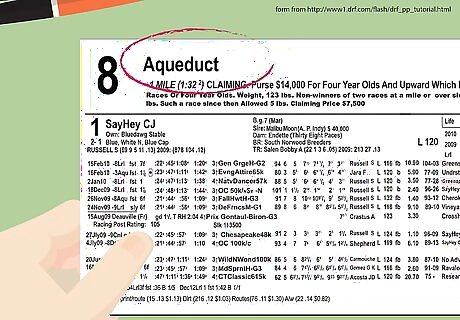
Find the track name. This will be in particularly large and bolded print, above all of the other information in the header, excluding the race number which will be to its left.
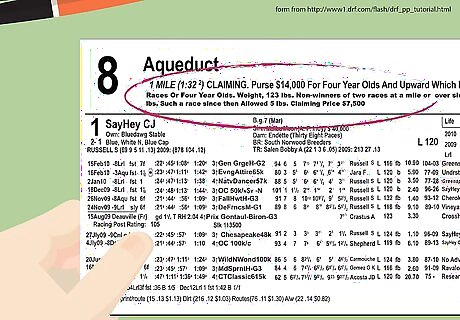
Find race conditions. Underneath the track name, there will approximately three lines worth of description. This will begin with the length of the race, the track record, the purse that goes to the winner. It will also list conditions that were necessary for the horses to qualify for the race. Race participants will often be limited by specifying the horses’ gender, age, and record. These class specifications will be listed in the race conditions. Alternatively, you will see an alpha-numeric code to the right of track name and above the race conditions. These codes are used to convey most of the information included in the race description. That makes it possible for experts to quickly scan the header for race information.
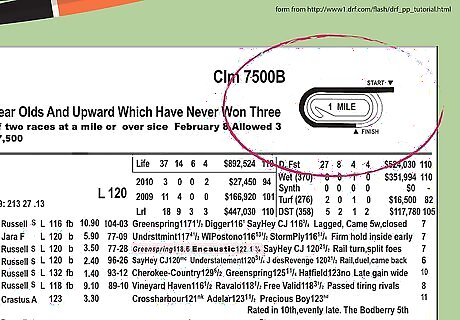
Review the track diagram. On the far right-hand side of the header, you can find a picture of the course. This can be a meaningful tool, because some horses perform better on specific types of races.
Reviewing Individual Horse information
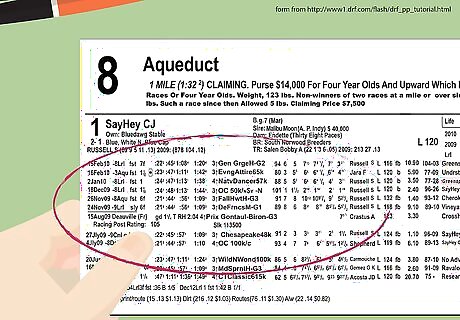
Find Horse Information. Directly under the track information you’ll find three columns of data about the horse. This includes identifying information for the race, pedigree, and average performance history.
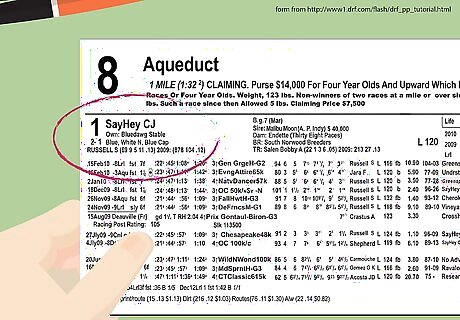
Look to the far left column for identifying information. You will find the horse’s race number in large print to the left of the body of the text. The first row of text will tell you the horse's name and the second will tell you the owner’s name. The third row indicates the color of the “silks” the horse will wear during the race. The final line is the name of the horse’s jockey. Underneath the horse’s race number are the morning line odds, the standing odds prior to the race. For example, if the line odds are read 3 – 1, a successful bet of $1 will earn you $3. Adjacent to the jockey’s name you will find his statistics in parenthesis. The first number is the Jockey’s total number of starts for the meet, followed by first, second, and third-place finishes. The final number in parenthesis is the jockey’s win percentage. Next to this, you will find in a separate pair of parenthesis the jockey’s races, first-place finishes, and win percentage during the past year.
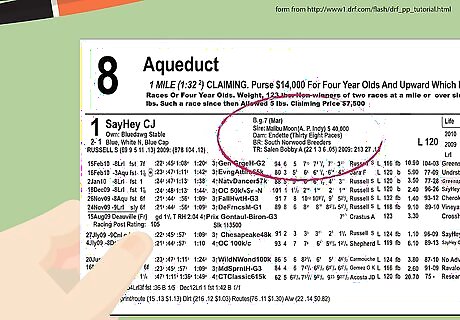
Look to the middle column for physical and pedigree information. The first row is composed of an initial indicating color, a second initial indicating gender, and a third indicating age. The second low lists the horse's sire, his sire’s sire, and how much, the owner charges to stud the sire. The third line lists the mother of the horse and the horse’s maternal grandfather. The fourth line provides the name of the breeder. The final line includes the trainer’s name, with his win percentage formatted the same way fashion as the jockey. The initials used to indicate color in the first line of the column are B for bay, Blk for black, Ch for chestnut, Dkb for dark bay, Br for brown, Gry for gray, and RA for roan. The color initial will be followed with a second indicating the gender of the horse. These are as follows: C for colt, F for filly, G for gelding, M for mare, and R for ridgling. The final element in the first line is the horse's age. An example of how this I formatted is “4 (May),” where 4 is the age of the horse, and May is the month in which the horse is born. The age of a horse is measured not by the number of their birthdays, but rather by how many New Year’s Days they have seen. A horse born on December 31st will be considered one year old on January 1st.
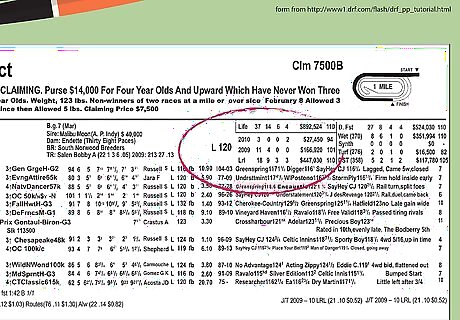
Find career averages on the far right column. To the left on the column will find in large print a letter and a number, indicating any medications the horse might be on and any weight that it might be carrying. You will find the rows formatted to display the horse’s career statistics. The first number indicates total career starts, followed by first place, second, and third-place finishes. To the right of this, you will see career earnings and the horse's best Beyer Speed. There are a handful of rows formatted in this fashion to indicate the horse’s performance under different circumstances. The first row, beginning on the upper left, is the horse’s career record. The three indicate this horse’s performance this year, the prior year, and historically at this track. From the top right down the rows represent the horse’s record on a dirt fast track, wet track, synthetic track, turf record, and the horses’ record with surfaces and distances similar to that of the race in question. The Beyer speed is a measure of a horses’ average speed relative to the average speed of the tracks it has run. For a $25,000 race average Beyer numbers would be in the low 90s, mid 80s for a $10,000 race, and 57 for a $2,500 race. Top horses might have Bayer numbers in the 120’s. Next to the wet, turf, and distance symbols you will find a number in parenthesis known as the “Tomlinson Rating.” This indicates how well a horse performs on those types of tracks. A rating of 320 or more for wet turf or distance suggests that the horse will likely run particularly well on a wet track. For turf a ranking of 280 or more indicates that the horse has an advantage in the race.
Reviewing Past Races
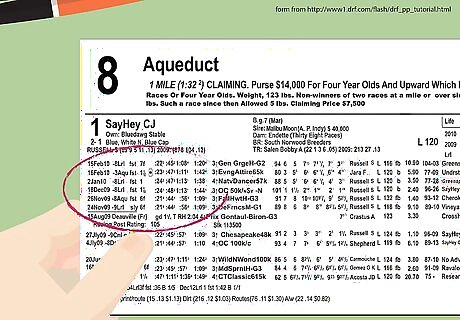
Study the horse's performance in recent races. Underneath the general horse information you can find a list of the horse’s performances in earlier races. Each of these rows will begin with a date, identifying the race, followed by detailed and extensive information.
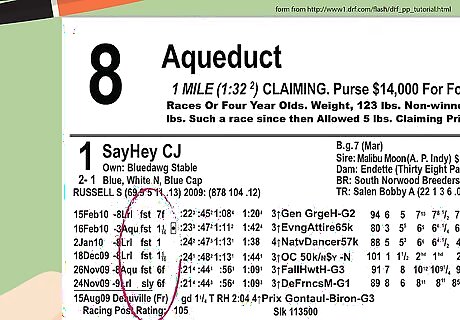
Find identifying race information. At the beginning of the row you will find the date of the race, an abbreviation indicating the track and the race number for that day. This will follow with an abbreviation indicating the condition of the track. The final piece of information before fractional times the distance measured in furlongs. Track condition abbreviations include fr for frozen, fst for fast, gd for good, hy for heavy, my for muddy, sl for slow, sly for sloppy, and wf. For wet-fast.
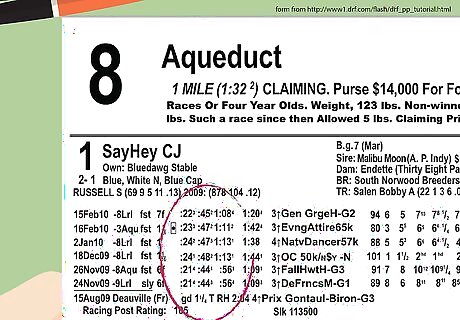
Review fractional times. These give you a sense of how the horse paces itself through a race. The first number is the horse's time at a quarter of the distance of the course, the second at a half-mile, the third at three-fourths of a mile and the last number the horse’s final time. Times are formatted like “2:04 3” where “2” is a measure of minutes, “04” a measure of seconds, and “3” a measure of fifths of a second.
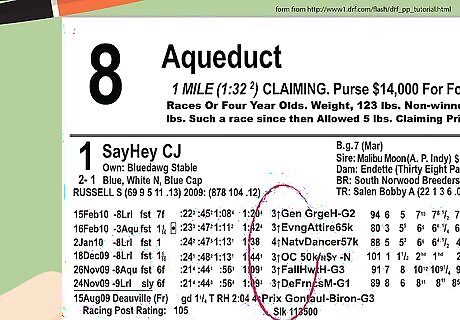
Review horse position. After the times you’ll find a number indicating the horse’s Beyer’s speed. This is followed by the horse’s position at post, first call, second call, third call, stretch call, and finish. The exponent for the number indicates how many lengths (an approximate measure of the length of a horse) the horse was behind the race leader. On the far right of the page you will find a number that represents the number of starters. This is important when considering how favorable the horse’s position is. If there are only 4 starters, a third-place position won’t can't for much. Read comments. On the far right just before the number of starts you will find a comment line. Though short, this will usually give some information about the horses performance that might be hard to ascertain just from the numbers.
Using the Racing Form to Win
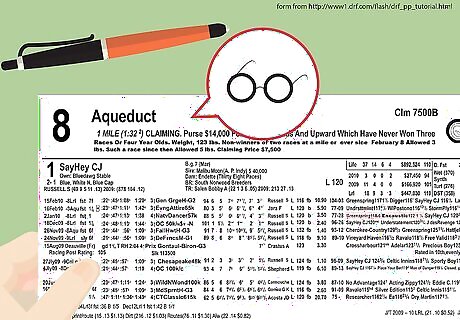
Beat the odds. When a horse is favored to win, the odds will be set up so that any bets on that horse won’t payout as much. Thus, you shouldn’t see yourself as betting for a horse, so much as you are betting against the odds makers. Use the Racing Form to try to predict when a horse is likely to do better than the odds makers believe.
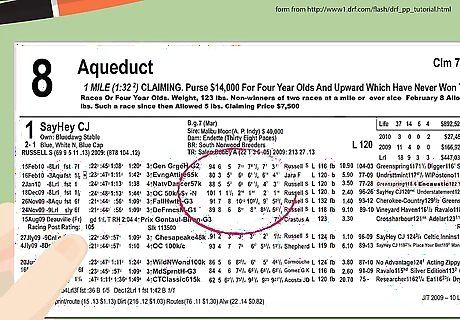
Study the Beyer Speed Figure. A high Beyer Speed Figure, especially in recent races, is the standard measure for calculating a horses odds. However, if your objective is to beat the odds, you should be especially careful to observe reasons why the Beyer Speed Figure might be flawed. Did track conditions cause the horse to perform unusually poorly in a recent race? If so, the odds makers may very well be underestimating its chances.
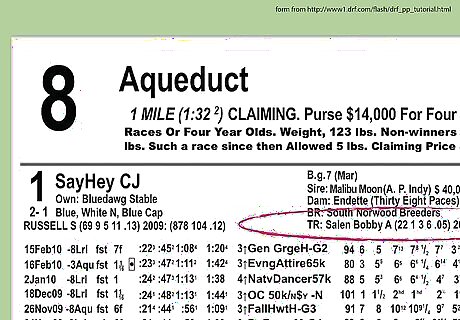
Study the effectiveness of the horse's trainer. A good trainer might be able to take a horse with a mediocre past and encourage it to perform better. Studying the trainer is a good way to determine when a horse might outperform the odds.
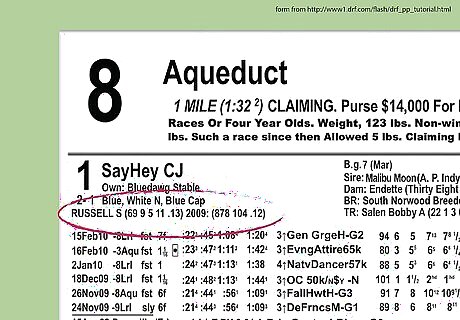
Gauge the ability of the horse's jockey. Below the horse's name in bold type is the name of its rider. The jockey's statistics cover the same time frame as the trainer's statistics.
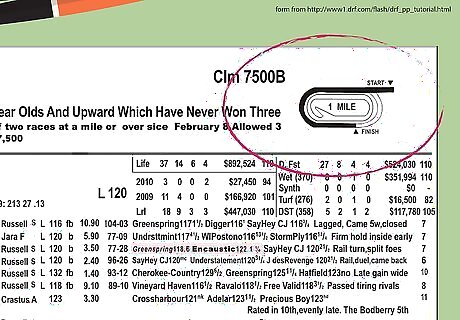
Think about the course. Historically, some horses have only performed well on specific courses. Review the horse’s performance at the track to see if it might have an advantage there. Also, consider whether the horse has performed well on similar types of courses and distances in the past.
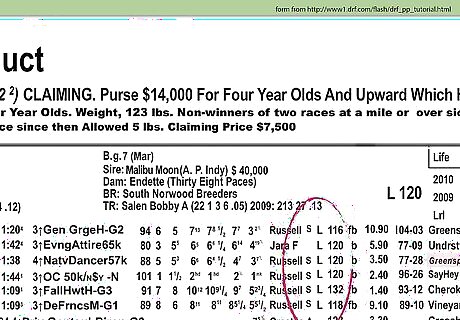
Determine whether the horse has added medication. Horses treated with Lasix for the first time often perform better than expected. This will be indicated by a large “L” next to the left of the horse’s average Beyer Speed Numbers. A horse that has just taken it for the first time (as opposed to one that has been on it) will be indicated with a white “L” in a black circle.
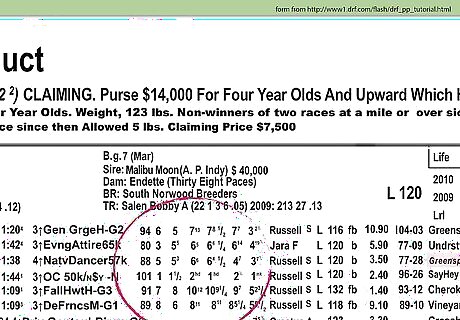
Try position handicapping. One of the most complicated features of horse betting is ascertaining how a horse interacts with other horses. Does it want to try to stay in front or break out toward the end? Study the horse’s position relative to other horses on the track to ascertain its type and then consider how it might interact with the other types of horses in the race that day.
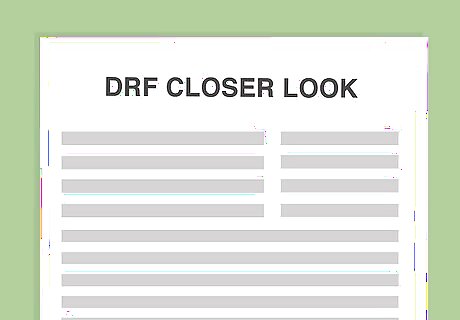
Embrace expert opinions. "The Closer Look" section in the Racing Form is a brief narrative on each horse written by a professional handicapper. It often contains important pedigree data, clues on workout patterns, and insights on previous races.




















Comments
0 comment